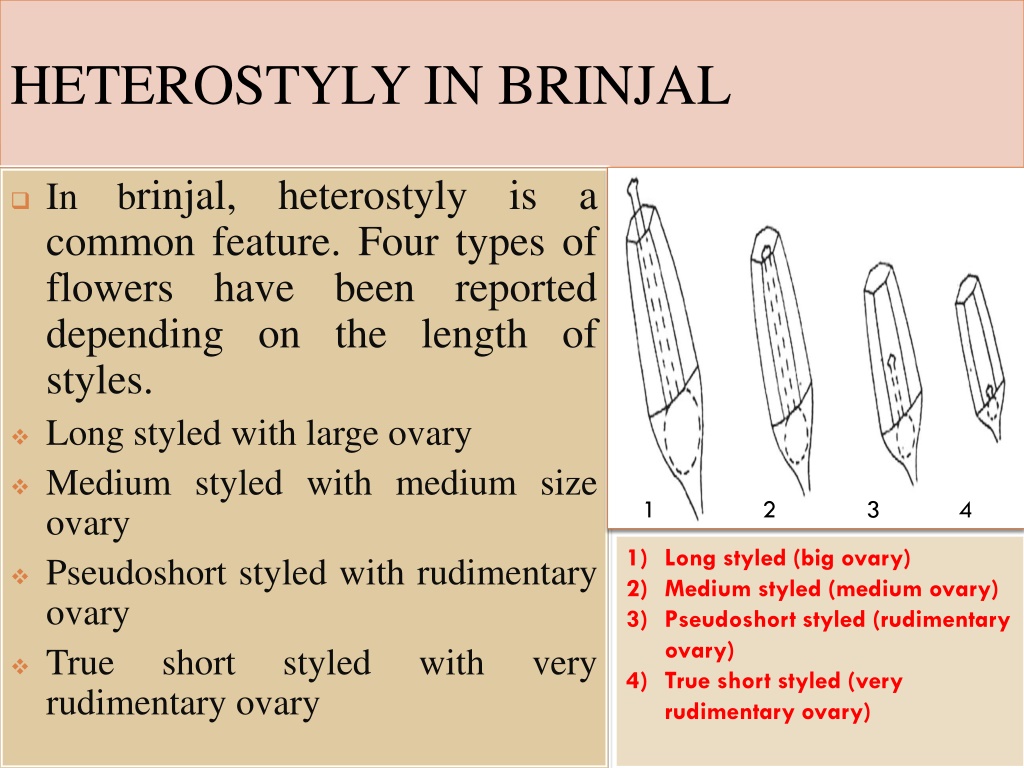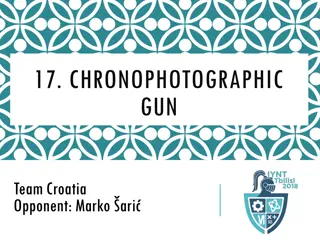Understanding Heterostyly and Physiological Disorders in Brinjal
Heterostyly in brinjal involves four types of flowers with varying styles impacting fruit setting, while physiological disorders like poor fruit set, calyx withering, and freezing injury can affect the crop's productivity. Controlling measures for each disorder are discussed to help manage these issues effectively.
Uploaded on Mar 08, 2024 | 0 Views
Download Presentation

Please find below an Image/Link to download the presentation.
The content on the website is provided AS IS for your information and personal use only. It may not be sold, licensed, or shared on other websites without obtaining consent from the author. Download presentation by click this link. If you encounter any issues during the download, it is possible that the publisher has removed the file from their server.
E N D
Presentation Transcript
HETEROSTYLY IN BRINJAL brinjal, heterostyly is a In common feature. Four types of flowers have depending on the length of styles. Long styled with large ovary Medium styled with medium size ovary Pseudoshort styled with rudimentary ovary True short styled rudimentary ovary been reported 1 2 3 4 1) Long styled (big ovary) 2) Medium styled (medium ovary) 3) Pseudoshort styled (rudimentary ovary) 4) True short styled (very rudimentary ovary) with very
Brinjal productivity It has been reported that long and medium styled flowers produce fruits whereas pseduoshort and short-styled flowers do not set any fruits. Further, chances of cross pollination are more in long style flowers. The percentage of long and medium styled flowers is a varietal character. Fruit setting of long styled flowers varies from 70% to 86.1% in different varieties. In medium styled flowers, fruit set ranges from 12.5% to 55.6% . All varieties have flowers with different style length. The position of the stigma in relation to stamens varies with the cultivars and can also vary in different flowers of same cultivar. Stigmas are either found above, on the same level as or below the stamens and the highest percentage of fruit set is found where the stigma is above the stamens.
POOR FRUIT SET :- Pseudo short and short flower do not normally set fruit but their numbers in a plant are normally higher than long and medium styled flower which produce fruits. Flowers are normally borne solitarily as well as in clusters. The solitary flowers are mostly long or medium styled where as mixtures of short styled , pseudo short styled and medium / long styled flowers are found in the clusters. Ratio of short styled flowers to long / medium styled flowers in clusters is much high ( 3-4 : 1 ) . Natural drop is also a problem in brinjal which may be as high as 50 % in medium styled flower and 30 % in long styled flower CONTROL :- Spraying the plant with 2 ppm 2 , 4 D at flowering stage when few flower clusters appear. Spraying with (Parachloroacetic acid ) at full bloom stage. 60 ppm NAA or 500 ppm PCPA
CALYX WITHERING This disorder occurs between mid February and mid April. Ca withering excess cause calyx The affected fruits become reddish brown The affected fruits have much higher calcium content than healthy ones. and nitrate
FREEZING INJURY It is mainly a storage disorder. It occurs when ice crystals form in the tissues. Freezing injury will be initiated at 0.8 c depending on the soluble solids content. SYMPTOMS :- Water soaked pulp it become Brown and desiccated in appearance over time. PRECAUTION :- Harvesting should be done by cutting the calyx stem free from the plant rather than by tearing. cotton gloves are often used.
CHILLING INJURY :- Egg plant fruit are chilling sensitive at temperature below 10 c . At 5 c chilling injury will occur in 6-8 days Consequences of chilling injury are pitting, surface bronzing and browning of pulp tissue Accelerated decay by Alternaria species is common in chilling stressed fruit Chilling injury is cumulative and may be initiated in the field prior to harvest. CONTROL :- Chilling injury can be reduced by storing polyethylene bags overwraps. of eggplant polymeric in or film
Effect of low temperature storage on physical and physiological characteristics of eggplant fruit (Solanum melongena L.) The chilling injury (CI) symptoms as well as some physiological implications were studied in eggplants Money Maker No. 2 stored at 0 and 10 C for 15 days. Eggplants stored at 10 C were not damaged by temperature, whereas fruit stored at 0 C suffered CI. Eggplant stored at 0 C exhibited a decrease in L0 (lightness) and L (oxidation potential), increase of pH and electrolyte leakage after CI symptoms are manifested. In fruit stored at this temperature and in upper section, changes of anthocyanin content with time were closely proportional to the Chroma evolution (lower content of anthocyanin, lower saturation of colour). CONCLUSION :- The chilling injury index (CI) of eggplant cv Money Maker No. 2 experienced a significant increase over 15 days of storage at 0 C, and symptoms were more severe in upper section. On the contrary, no evolution of damage was observed at 10 C. The strong increase in flesh browning at 0 C was represented by a decrease in lightness (L0) and oxidation potential ( L). Moreover, at this temperature, the onset of disruption in cell structures and membranes. Colour parameters from upper section were more affected by storage at 0 C than those from the central section. However, changes in anthocyanin content were observed in both sections. The anthocyanin content in central section was higher than in upper section at harvest and during storage. This was possibly a consequence of the weaker damage in central section, since anthocyanins are known to have antioxidant properties.
Eggplant (Solanum melongena L.) flowering and fruiting dynamics depending on pistil type as well as way of pollination and flower hormonization The experiment was carried out in three unheated plastic tunnels in 1998 2000. The aim of this study was observation on flowering dynamics and estimation of the effects of flower s heterostyly and two ways of flower pollination (self-pollination and using bumble-bee) as well as flower hormonization on the fruiting dynamics of three cultivars of eggplant: Black Beauty , Solara F1 , and Epic F1 . CONCLUSIONS 1. Eggplants began their flowering in June in three years of study. Period of the most intensive flowering occurred in July 1998, and in August 1999 and 2000. Black Beauty produced the greatest number of flowers with medium-styled pistil, Solara F1 and Epic F1 long-styled flowers. 2. The first fruit sets appeared in June from flowers with long-styled pistil. For all pollination methods, the greatest number of fruits developed from long-styled flowers. Plants, whose flowers were pollinated by bumble bee and hormonized, set great number of fruits also from flowers with medium and short-styled pistil. 3. The best fruit setting for every combination was observed in July and August during the abundant eggplant s flowering. In 1998 1999, the greatest number of fruits developed from long-styled flowers in the case of Solara F1 and Epic F1 and from medium-styled flowers at Black Beauty . In 2000 at three eggplant cultivars, there was higher number of fruits developed from long-styled flowers than from flowers with medium and short-styled pistil.

























